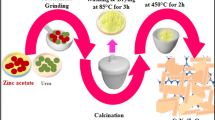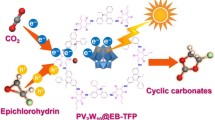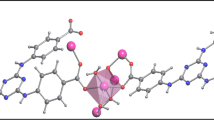Abstract
Most of the studies performed with porphyrins involve these species functionalized with peripheral substituents lying on the same macrocyclic molecular plane. The main objective of this work deals with the successful preservation and optimization of the fluorescence of a uncommonly used porphyrin species, i.e. tetrakis-(ortho-amino-phenyl)-porphyrin; a molecule with substituents localized not only at one but at both sides of its molecular plane. In cases like this, it must be stressed that fluorescence can only be partially preserved; nevertheless, intense fluorescence can still be reached by following a twofold functionalization strategy involving: (i) the bonding of substituted macrocycles to the pore walls of (ii) organo-modified silica monoliths synthesized by the sol–gel method. The analysis of both absorption and emission UV spectra evidenced a radiation energy transfer taking place between the porphyrin and the host silica matrix. Our results showed that the adequate displaying of the optical properties of macrocyclic species trapped in SiO2 xerogels depend on the polarity existing inside the pores, a property which can be tuned up through the adequate selection of organic groups used to modify the surface of the pore cavities. Additionally, the pore widths attained in the final xerogels can vary depending on the identity of the organic groups attached to the network. All these facts finally demonstrated that, even if using inefficient surface functionalization species, such as ortho-substituted tetraphenylporphyrins, it is still possible to modulate the pore shape, pore size, and physicochemical environment created around the trapped macrocycles. The most important aspect related to this research deals with the fact that the developed methodology offers a real possibility of controlling both the textural and morphological characteristics of a new kind of hybrid porous materials and to optimize the physicochemical properties of diverse active molecules trapped inside the pores of these materials.















Similar content being viewed by others
References
Berezin BD (1962) The thermodynamic characteristics of Phthalocyuanines in Aulphuric acid solutions. Russ J Inorg Chem 7:1300–1303
Smith KM (1976) Porphyrins and Metalloporphyrins. Elsevier Scientific Publishing Co, Amsterdam
Dolphin D (1979) The porphyrins, physical chemistry, part a and B. Academic Press, New York
Milgrom RL (1997) The colour of life; an introduction to the chemistry of porphyrins and related compounds. Oxford University Press, Oxford
Darwent JR, Douglas P, Harriman A, Porter G, Richoux MC (1982) Metal phthalocyanines and porphyrins as photosensitizers for reduction of water to hydrogen. Coord Chem Rev 44:83–126
Bedioui F (1995) Zeolite-encapsulated and clay-intercalated metal porphyrin, Phthalocyanine and Schiff-base Complexes as Models for Biomimetic Oxidation Catalysts: An Overview. Coord Chem Rev 144:39–68
Friedrich J, Wolfrum H, Haarer D (1982) Photochemical holes: a spectral probe of the amorphous state in the optical domain. J Chem Phys 77:2309–2316
Friedrich J, Wolfrum H, Haarer D (1992) Direct measurements of nonlinear absorption and refraction in solutions of phthalocyanines. Appl Phys B Lasers Opt 54(1):46–51
Kamitani K, Uo M, Inoue H, Makishima A (1993) Synthesis and spectroscopy of TPP’S-doped silica gels by the Sol–gel process. J Sol-Gel Sci Technol 1:85–92
Wang XJ, Yates LM III, Knobbe ET (1994) Study of nonlinear absorption in Metalloporphyrin-doped Sol–gel materials. J Lumin 60–61:469–473
Dunbar ADF, Brittle S, Richardson TH, Hutchinson J, Hunter CA (2010) Detection of volatile organic compounds using porphyrin derivatives. J Phys Chem B 114:11697–11702
Nakagawa K, Aono T, Ueda G, Tsutsumi C, Hayase N, Manuchi M, Sadaoka Y (2005) Development of an eco-friendly optical sensor element based on tetraphenylporphyrin derivative disperse in biodegradable polymer: effects of substituents of tetraphenyl-porphyrins on HCl detection and diodegradation. Sensors Actuators B Chem 108:542–546
Borisov SM, Lehner P, Klimant I (2011) Novel optical trace oxygen sensors based on platinum(II) and palladium(II) pomplexes with 5,10,15,20-Meso-tetrakis-(2,3,4,5,6-pentafluorophenyl)-porphyrin covalently inmobilized on silica-gel particles. Anal Chim Acta 690:108–115
Radhakrishnan A, Rejani P, Beena B (2014) Synthesis, characterization and antimicrobial properties of CuO nanoparticles against gram-positive and gram-negative bacterial strains. Int J Nano Dimens 5(6):519–524
Messaoud M, Chadeau E, Brunon C, Ballet T, Rappenne L, Roussel F, Leonard D, Oulahal N, Langlet M (2010) Photocatalytic generation of silver nanoparticles and application to the antibacterial functionalization of textile fabrics. J. Photochem Photobiol A Chem 215:147–156
Harriman A (1980) Luminescence of porphyrins and Metalloporphyrins part I. J Che Soc Faraday Trans 1 76:1979–1985; Part II, 1981, 77:369; Part III 1981, 77:1281–1291
Sternberg ED, Dolphin D, Brickner C (1998) Porphyrin-based photosensitizers for use in photodynamic therapy. Tetrahedron 54:4151–4202
Lavi A, Weitman H, Holmes RT, Smith KM, Ehrenberg B (2002) The depth of porphyrin in a membrane and the membrane’s physical properties affect the photosensitizing efficiency. Biophys J 82:2101–2110
Dougherty TJ, Thoma RE, Boyle D, Weishaupt KR (1980) Photoradiation therapy for the treatment of malignant tumors: role of the laser. In: Pratesi R, Sacchi CA (eds) Laser in photomedicine and photobiology. Springer, New York, pp. 67–75
Huang H, Song W, Rieffel J, Lovell JF (2015) Emerging applications of porphyrins in Photomedidine. Front Phys 3(23):1–15
Malik Z, Landan H, Erenberg B, Nitzan Y (1992) Bacterial and viral Photodinamic inactivation. In: Henderson BW, Dougherty TJ (eds) Photodynamic Theraphy: medical applications. Marcel Dekker Inc. New York, Buffalo, pp. 97–113
Weizman E, Rothman CH, Greenbaum L, Shainberg A, Adamek M, Ehrenberg B, Malik Z (2000) Mitocondrial localization and photodamage during photodynamic therapy with tetraphenylporphines. J Photochem Photobiol B 59:92–102
Reddi E, Ceccon M, Valduga G, Jori G, Bommer JC, Elisei F, Latterini L, Mazzucato U (2002) Photophysical properties and antibacterial activity of meso-substituted cationic porphyrins. Photochem Photobiol 75:462–470
Sanchez C, Rozes L, Ribot F, Laberty-Robert C, Grosso D, Sassoye C, Boissiere C, Nicole L (2010) “Chimie douce”: a land of opportunities for the designed construction of functional inorganic and hybrid organic–inorganic nanomaterials. C R Chim 13:3–39
Levy D, Reisfeld R, Avnir D (1984) Fluorescence of europium (III) trapped in silica gel-glass as a probe for cation binding and for changes in cage symmetry during gel dehydration. Chem Phys Lett 109:593–597
Pouxviel JC, Dunn B, Zink JI (1989) Fluorescence study of aluminosilicate sols and gels doped with hydroxy trisulfonated pyrene. J Phys Chem 93:2134–2139
Miller JM, Dunn B, Valentine JS, Zink JI (1996) Synthesis conditions for encapsulating cytochrome c and catalase in SiO2 Sol–gel materials. J Non-Cryst Solids 202:279–289
Campostrini R, Carturan G, Caniato R, Piovan A, Filippini R, Innocenti G, Cappelletti EM (1996) Immobilization of plant cells in hybrid sol–gel materials. J Sol-Gel Sci Technol 7:87–97
Nassif N, Roux C, Coradin T, Rager MN, Bouvet OMM, Livage J (2003) A sol–gel matrix to preserve the viability of encapsulated bacteria. J Mater Chem 13:203–208
García-Sánchez MA, Campero A (1998) aggregation properties of metallic tetrasulphophtalocyanines encapsulated in sol–gel materials. J Sol-Gel Sci Technol 37:651–655
García-Sánchez MA, Campero A (2000) Aggregation properties of metallic tetrasulfophthalocyanines embedded in sol–gel silica. Polyhedron 19:2383–2386
García-Sánchez MA, Campero A (2001) Insertion of lanthanide porphyrins in silica gel. J Non-Cryst Solids 296:50–56
García-Sánchez MA, Tello-Solís SR, Sosa-Fonseca R, Campero A (2006) Fluorescent porphyrins trapped in monolithic SiO2 gels. J Sol-Gel Sci Technol 37:93–97
García-Sánchez MA, de la Luz V, Estrada-Rico ML, Murillo-Martínez MM, Coahuila-Hernández MI, Sosa-Fonseca R, Tello-Solís SR, Rojas F, Campero A (2009) Fluorescent porphyrins covalently bound to silica xerogel matrices. J Non-Cryst Solids 355:120–125
García-Sánchez MA, de la Luz V, Coahuila-Hernández MI, Rojas-González F, Tello-Solís SR, Campero A (2011) Effects of the structure of entrapped substituted porphyrins on the textural characteristics of silica network. J Photochem Photobiol A Chem 223:172–181
González-Santiago B, García-Sánchez MA (2011) Macrocycle–pore network interactions: aluminum tetrasulfophthalocyanine in organically modified silica. J Non Cryst Solids 357:3168–3175
Quiroz-Segoviano RIY, Garcia-Sánchez MA, Rojas-González F (2012) Cobalt porphyrin covalently bonded to organo modified silica xerogels. J Non-Cryst Solids 358:2868–2876
Quiroz-Segoviano RIY, Serratos IN, Rojas-González F, Tello-Solís SR, Sosa-Fonseca R, Medina-Juarèz O, Menchaca-Campos C, García-Sánchez MA (2014) On tunin fluorescence emission of porphyrins fee bases bonded to the pore walls of organo-modiffied silica. Molecules 19(2):2261–2285
Hambright P, Gore T, Burton M (1976) Synthesis and characterization of new isomeric water-soluble porphyrins. Tetra(2-N-methylpyridyl)porphine and tetra(3- N-methylpyridyl)porphine. Inorg Chem 15(9):2314–2315
Reid JB, Hambright P (1977) Kinetics of copper incorporation into tetra(2-N–methylpyridyl)porphine. Effects of basicity on rate. Inorg Chem 16:968–969
Shamim A, Hambright P (1980) An equilibrium and kinetic study of water-soluble cadmium porphyrins. Inorg Chem 19:564–566
Kim JB, Leonard JJ, Longo FR (1972) A mechanistic study of the synthesis and spectral properties of meso-tetraphenylporphyrin. J Am Chem Soc 94:3986–3992
Egorova GD, Knyukshto VN, Solovev KN, Tsvirko MP (1980), Intramolecular spin-orbital perturbations in ortho- and meta-halogeno-derivatives of tetraphenylporphin Opt Spectrosc (USSR) 48(6):602–7; Opt Spectrosc (english translation) 1980 48;1101–1109.
Rothemund P (1936) Porphyrin studies III, the structure of the porphine ring system. J Am Chem Soc 61:2912–2915
Adler AD, Longo FR, Finarelli JD, Goldmacher J, Assour J, Korsakoff L (1967) A simplified synthesis for meso-tetraphenylporphin. J Organomet Chem 32(2):476–476
Adler AD, Logo FR, Kampas F, Kim J (1970) On the preparation of metalloporphyrins. J Inorg Nucl Chem 32(7):2443–2445
Sing KSW, Everett DH, Haul RAW, Moscou L, Pierotti RA, Rouquerol J, Siemieniewska T (1985) Reporting physisorption data for gas/solid systems with special reference to the determination of surface area and porosity. Pure Appl Chem 57:603–619
Gregg SJ, Sing KSW (1967) Adsorption, Surface Area and Porosity. Academic Press, London
Tomé AC, Silva AMS, Alkorta I, Elguero J (2011) Atropisomerism and conformational aspects of meso-tetraarylporphyrins and related compounds. J Porphyrins Phthalocyanines 15:1–28
Dirks JW, Underwood G, Matheson JC, Gust D (1979) Conformational dynamics of. alpha.,.beta.,.gamma.,.delta.-tetraarylporphyrins and their dications. J Organomet Chem 44:2551
Medforth CJ, Haddad RE, Muzzi CM, Dooley NR, Jaquinod L, Shyr DC, Nurco DJ, Olmstead MM, Smith KM, Ma JG, Shelnutt JA (2003) Unusual aryl − porphyrin rotational barriers in peripherally crowded porphyrins. Inorg Chem 42:2227–2241
Gouterman M (1961) Spectra of porphyrins. J Mol Spectrosc 6:138–163
Gouterman M, Wagnière GH, Snyder LC (1963) Spectra of porphyrins: part II. Four orbital model. J Mol Spectrosc 11:108–127
Seybold PG, Gouterman M (1969) Porphyrins XIII, fluorescence spectra and quantum yields. J Mol Spectrosc 31:1–13
Goutermam M, Khalil G-E (1974) Porphyrin Free Base phosphorescence. J Mol Spectrosc 53:88–100
Maiti NC, Mazumdar S, Periasamy N (1998) J- and H-aggregates of porphyrin-surfactant complexes: time-resolved fluorescence and other spectroscopic studies. J Phys Chem B 102:1528–1538
Kitagawa Y, Hiromoto J, Ishii K (2013) Electronic absorption, MCD, and luminescence properties of porphyrin J-aggregates. J Porphyrins Phthalocyanines 17:703–711
Lomova TN, Berezin BD (2001) Porphyrin complexes with p, d, and f metals in high oxidation states: structures, electronic absorption, and IR spectra. Russ J Coord Chem 27(2):85–104
Ferreira JA, Barral R, Baptista JD, Ferreira MIC (1991) Absorption coefficients and fluorescence quantum yield of porphyrin films determined by optical and photoacustic spectroscopies. J Lumin 48–49:385–390
Peri JB (1966) Infrared study of OH and NH2 groups on the surface of a dry silica aerogel. J Phys Chem 70(9):2937–2945
Orgaz F, Rawson H (1986) Characterization of various stages of the sol- gel process. J Non-Cryst Solids 82:57
Wood DL, Rabinovich EM (1986) Infrared studies of alkoxide gels. J Non-Cryst Solids 82:171–176
Acknowledgments
The authors wish to thank the Ministry of Education (SEP-PRODEP) for the support awarded to the Academic Body “Fisicoquímica de Superficies” (UAM-I CA-031), to the Academic Network “Diseño Nanoscópico y Textural de Materiales Avanzados”, SEP-PROMEP (UAM-PTC-459) and for grant number 22209 awarded to T.T.E. Authors also wish to thank the National Science and Technology Council of Mexico (CONACYT) for the financement of projects 168692 and CB-2010-01 154962.
Author information
Authors and Affiliations
Corresponding author
Rights and permissions
About this article
Cite this article
García-Sánchez, M.A., Serratos, I.N., Sosa, R. et al. Fluorescence and Textural Characterization of Ortho-Amine Tetraphenylporphyrin Covalently Bonded to Organo–Modified Silica Xerogels. J Fluoresc 26, 1601–1616 (2016). https://doi.org/10.1007/s10895-016-1846-8
Received:
Accepted:
Published:
Issue Date:
DOI: https://doi.org/10.1007/s10895-016-1846-8




